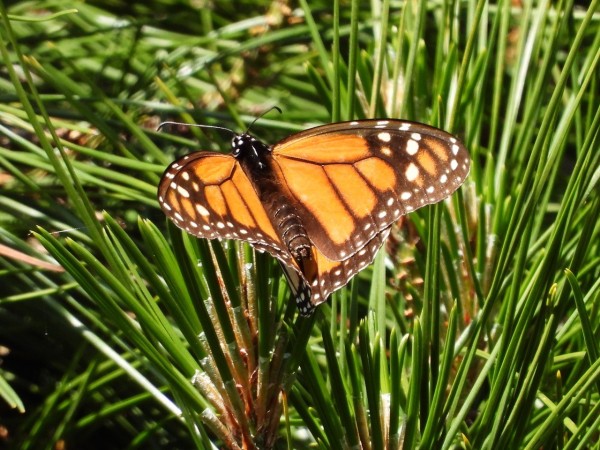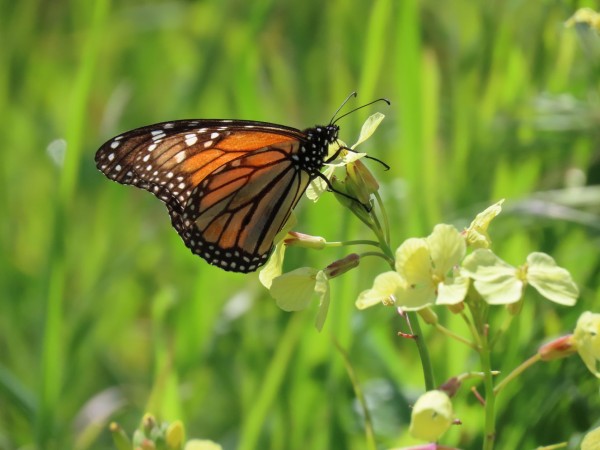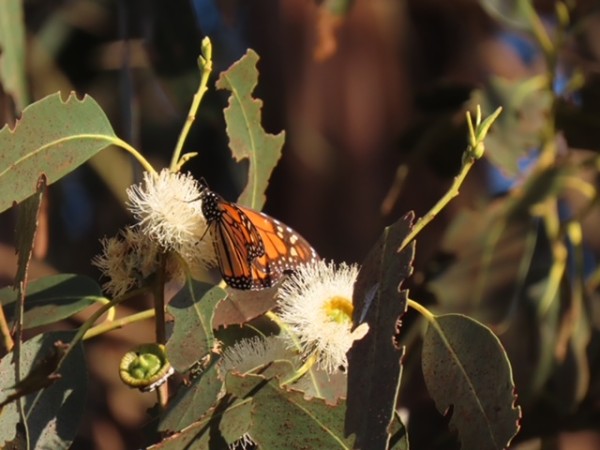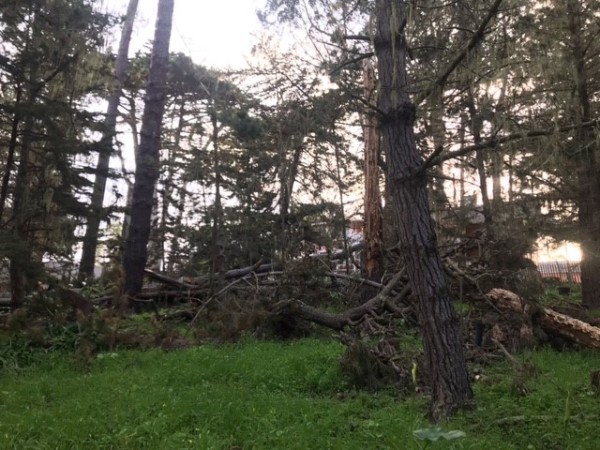Letter From Gail Morris: Western Monarch Spring 2023 Report #5
Western Monarchs Update
Last week the California coast was once again pummeled by another atmospheric river with battering sheets of rain and high winds. Rivers overflowed their banks, floods surged throughout the region and trees fell. Yet, despite the storm's intensity, when sunny clear days appeared, monarchs were on the move in an extraordinary fashion. Read about their mass dispersal, a rare event in California.
News from the California Overwintering Sites
Pacific Grove
Stephanie Turcotte shares her final report from the Monarch Sanctuary at Pacific Grove:
“Since the last count, per usual, I have been noting observations in and around the monarch habitat. Beginning on 3/11/23 there was suddenly a heavy stream of activity outside the grove, even along the coast. Similar to how the monarchs arrived in the fall, they were exiting in a similar fashion…flying in all directions. Although in the fall, I typically observe them flying as individuals. In this case, often I’d see them in multiples and one after the other whether I was walking or driving. For the last six days or so I have observed all the signs of mating outside the grove. It felt like a mass exodus, and I have actually never observed it quite on this scale since I began in 2012.
“On 3/14/23, PG experienced strong winds that once again brought trees down in this area and even on that day I saw a few monarchs flying. The photos that I attached I took when three monarchs landed on a Monterey Pine tree in my yard to the sun yesterday afternoon. I could identify at least two of them as male. So, I presumed that we’d have a low count compared to 5,405 on 3/7/23. Our final and official count this morning for the season is 333 monarchs. They were spread out in 6 trees, small clusters here and there, mostly on the perimeter trees in the west and east, very few in the north, hardly any in the interior- only on cypress and pines. All seemed primed to fly once the temps rise. (Note: Our final count for 2021 was 1,243 on 3/11)
“The monarch habitat looks quite battered after our last round of storms. We hope that the trees recover and understory plants have a chance to rejuvenate for the next monarch season. The volunteers who help care for the grove will have plenty to do.”
Lighthouse Fields
Diana Magor shares her observations from Lighthouse Fields in Santa Cruz:
“On 3-15-23 at noon, I surveyed Lighthouse Field and estimated ~ 80 monarchs still at or near the sanctuary. Most were flying in the fields surrounding the grove. Many were nectaring on both Eucalyptus flowers and on the plentiful wild radish (Raphanus sp.) in the surrounding fields. All that I could identify were males except for 1 female that was sunning on Eucalyptus and then taken down by a male, who eventually mated and flew off with her to the top of a Monterey cypress. The other pursuits were males chasing males. There were no clusters and only 1 monarch inside the main grove, sunning.”
While the monarchs are leaving, Diana is still very active in Santa Cruz working with others to restore windbreaks in the overwintering canopy in the area. We’ll share more next week about how the importance of restoration and growing early emerging native milkweeds are making a difference.
Reflecting on an unusual monarch overwintering season
Stephanie Turcotte shares her thoughts after the last count of the season at Pacific Grove:
“These monarch seasons always leave an impression on me. When they end there is a certain sadness. It is hard to see the monarchs go and literally disappear from this area until next fall. Typically, after the final count, the numbers just gradually decline and there are fewer and fewer that we see, until there are no more. And typically, you see some flying around the community, but that, too, is subtle in terms of numbers. This season was very different; the departure was so noticeable and abrupt. To have 5,405 monarchs just 10 days before and then drop to 333 monarchs inside the sanctuary was quite a shock to the system. What tempered it was that simultaneously there were hundreds and hundreds of monarchs flying outside the habitat. It’s as if they expanded the range of their habitat. It has been just lovely seeing them everywhere!
“Yesterday, I found my first dead monarch, .3 of a mile from the PG grove. A male monarch had perished and was wedged in between blades of local vegetation. I do wish we had some way to fill in the blanks once they leave this area. I think several of us heard that call to action at the Western Monarch conference in Pismo from Dr. David James and Dr. Chip Taylor and many other long-time researchers. We have all been wondering and speculating. However, I think more is being done to come up with a plan to gather the data related to where and how far these monarchs travel once they leave “us”.
“As with the close of every monarch season, I wonder what will happen next season. I have learned over the 11 seasons of doing this…. every season is different and not to have expectations because there are so many variables impacting all the generations in between this one and the ones that will arrive next October. One final thing I will say, the interior of the habitat in Pacific Grove is SO ravaged by the extreme weather this winter and many large trees have fallen in the neighborhood on all sides of the grove…. surely impacting windbreak. That, in itself, could impact what kind of season we will have (regarding providing suitable habitat) next season.
“I wish you a WONDER-filled spring and summer and look forward to continuing to provide your ‘glimpse into the Pacific Grove habitat’ next season. Until then… wishing you and the monarchs that are out there, especially the females with eggs, all the best.”
You can help fill these data gaps by reporting monarch and milkweed sightings throughout the year on Journey North!
Call for sightings!
Now that monarchs are on their way en route to the breeding grounds, your reports are critical to our understanding of their migration. Report your sightings of emerging milkweeds and monarchs in any life stage! Provide as much information as you can such as weather conditions (it’s okay to estimate). Your detailed description of what you see can include, but is not limited to, the monarch’s gender and activity and, if known, the type of milkweed, and flowers if they are nectaring. Let us know how monarchs are faring under stressors from winter storms still sweeping through! Be sure to check milkweeds for eggs, larvae, or pupae if you are lucky to find them.
Thank You!
A special Thank You to Stephanie Turcotte and Diana Magor for their reports and photos.
Gail Morris is the Coordinator of the Southwest Monarch Study (www.swmonarchs.org), a Monarch Watch Conservation Specialist, and the Vice President of the Monarch Butterfly Fund, the Central Arizona Butterfly Association and the Western Monarch Advocates. The Western Monarch Population News is based on comments provided to Gail Morris. We hope to increase the number of sightings and therefore photos and comments entered into the Journey North. We rely on the volunteers who communicate regularly with Gail and who agree to participate in our effort to increase awareness of the population of western Monarchs. You can reach her at gail@swmonarchs.org





